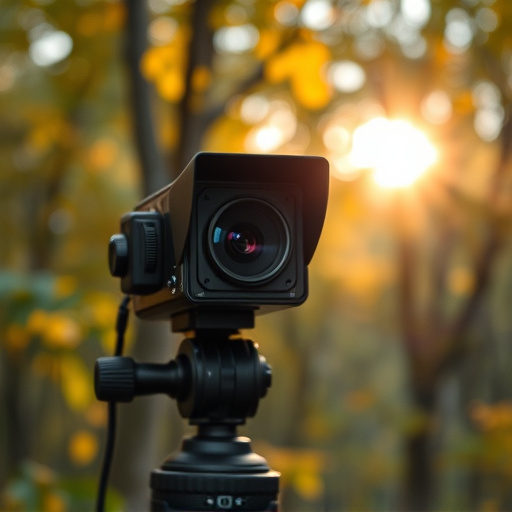Strategic placement of motion-activated cameras near doors and windows, combined with regular maintenance including footage review and calibration, significantly reduces false alarms for residential security. Avoiding camera positioning near natural motion areas, adjusting sensitivity settings, and implementing smart alert systems further prevent unnecessary police calls. Consistent firmware updates and sensor testing ensure optimal performance for effective intruder detection without nuisance alerts.
In today’s world, enhancing residential security is a top priority. One effective tool in your surveillance arsenal is a secret motion-activated camera, offering discreet protection without compromising privacy. This article delves into the intricacies of these cameras and provides essential tips for optimal installation. From understanding their advanced functionality to preventing costly false alarms, you’ll discover strategies to ensure your home remains secure. Explore the best practices for maintenance and security considerations to make your surveillance system a game-changer in protecting your residence.
- Understanding Motion Activated Cameras and Their Functioning
- Choosing the Right Location for Secret Camera Installation
- Techniques to Prevent False Alarms in Residential Settings
- Maintenance and Security Considerations for Effective Surveillance
Understanding Motion Activated Cameras and Their Functioning
Motion activated cameras, a key component in residential safety systems, function by detecting motion within their field of view and triggering recording automatically. This technology offers significant advantages for homeowners looking to deter intruders and monitor their properties. However, it’s crucial to understand their operation to minimise false alarm prevention.
False alarms can be costly and disruptive, often leading to unnecessary police responses. To prevent these, smart placement and camera calibration are essential. Positioning cameras strategically, away from common sources of motion like pets or passing vehicles, helps ensure accurate activations. Regularly reviewing footage and adjusting settings can further reduce false triggers, optimising the camera’s sensitivity and motion detection zones for accurate and reliable operation.
Choosing the Right Location for Secret Camera Installation
When selecting a location for your secret camera, prioritizing areas prone to potential intruders is key. Positioning the device near entry points like doors and windows offers strategic coverage, enabling it to capture unwelcome visitors without detection. A well-placed motion-activated camera can significantly reduce false alarm triggers by focusing on active movement, ensuring peaceful nights and effective security.
Consider factors such as line of sight, lighting, and potential blind spots. Cameras with night vision capabilities are ideal for capturing clear images even in low-light conditions. Regularly review footage to identify any recurring issues or areas that require additional coverage, allowing you to make informed adjustments for optimal false alarm prevention and overall residential safety.
Techniques to Prevent False Alarms in Residential Settings
Preventing false alarms is a key aspect of residential security, especially with the use of motion-activated cameras. To minimize false triggers, it’s essential to strategically place cameras, ensuring they have clear lines of sight while avoiding areas prone to natural movements like pets, children, or wind. Regularly testing and calibrating the sensors can also help reduce false alarms. Using camera settings that differentiate between human movement and environmental factors is another effective technique. Additionally, placing cameras at entry points and high-traffic areas ensures their sensitivity is justified, further cutting down on unnecessary alerts.
For motion-activated camera owners, understanding the technology’s limitations is crucial. Installing cameras with adjustable sensitivity levels allows for fine-tuning based on each area’s unique characteristics. Regular maintenance and updates to ensure the system operates at peak performance are also recommended. Emphasizing human oversight through monitoring or setting up smart alerts that notify residents before triggering an alarm can serve as a reliable false alarm prevention method.
Maintenance and Security Considerations for Effective Surveillance
Regular maintenance is key to ensuring your security system, including motion-activated cameras, functions optimally. Establish a routine inspection schedule to verify camera positioning, clarity of vision, and the overall integrity of the hardware. Clean lenses and ensure proper alignment to avoid distorted images or false alarm triggers from legitimate movements. Test all sensors periodically to identify any faulty components that could lead to unnecessary alerts.
Implementing measures for false alarm prevention is crucial for effective surveillance. Adjust sensitivity settings carefully to distinguish between genuine threats and environmental factors like pets, wind, or passing vehicles. Consider using advanced features like motion tracking and smart learning algorithms that can recognize familiar patterns, reducing the chances of spurious triggers. Regular updates to firmware and security protocols will also contribute to a robust residential safety network.
Secret camera mounting for residential safety can significantly enhance home security, but it’s crucial to implement these tips thoughtfully. By understanding motion activated cameras and their optimal placement, preventing false alarms through smart positioning, and maintaining regular surveillance equipment checks, you can ensure a secure living environment. Remember, the key to effective home protection lies in combining advanced technology with strategic installation practices.
